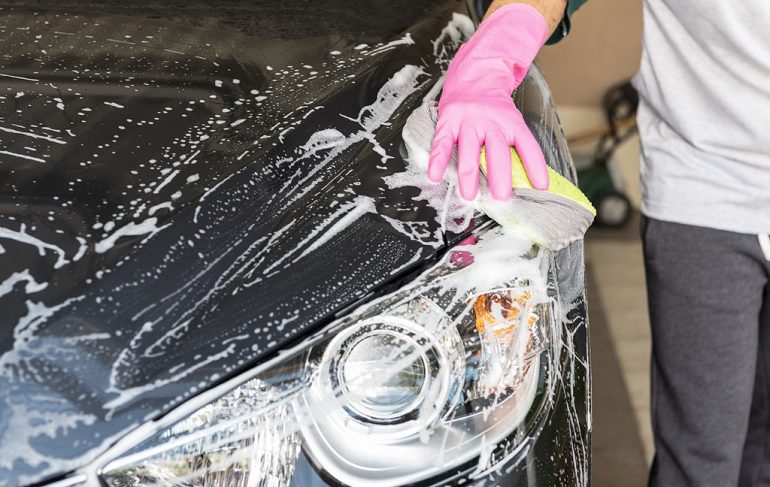
Keeping your car clean and well-detailed not only enhances its appearance but also preserves its value and protects the paintwork. However, to achieve a truly flawless finish, it’s essential to follow the right techniques and use the appropriate products. We will walk you through the step-by-step process of properly washing and detailing your car, ensuring professional results every time. We’ll also provide additional information and safety precautions to help you avoid any potential damage to your vehicle.
Before starting the car washing and detailing process, it’s crucial to assemble all the necessary tools and supplies. Here are the top 10 items you may want to gather:
Begin by rinsing your car with a gentle stream of water using a hose. This step helps remove loose dirt and debris, reducing the chance of scratching during the wash process. Focus on the wheels and wheel arches as they tend to accumulate more grime.
Mix the car wash shampoo with water according to the instructions on the bottle. Starting from the top of the car, work your way down, using a microfiber wash mitt or sponge. Gently scrub the car’s surface in straight lines, applying light pressure. Rinse the mitt or sponge frequently in a separate bucket of clean water to avoid reintroducing dirt onto the paintwork. Pay extra attention to lower areas where dirt tends to accumulate, such as the bumper and rocker panels.
Apply a suitable wheel cleaner to the wheels and let it dwell for the recommended time. Use soft-bristle brushes to scrub away brake dust and grime. Avoid using stiff brushes or aggressive scrubbing motions, as they can cause scratches or damage to the wheel finish. Rinse thoroughly. For tires, use a dedicated tire cleaner and a tire brush to remove stubborn dirt. Rinse again and dry the wheels and tires.
For an extra smooth finish, consider using a clay bar with a lubricant to remove embedded contaminants from the paintwork. Lubricate the surface with the provided clay lubricant and gently glide the clay bar back and forth. This process helps remove contaminants, but it requires caution to prevent scratching. Fold and knead the clay bar regularly to expose a clean surface.
Using a soft, absorbent microfiber towel, gently dry the car’s surface to avoid water spots. Pat the surface dry rather than rubbing forcefully, as rubbing can cause swirl marks. Start from the top and work your way down, ensuring all areas are thoroughly dried.
Before cleaning the interior, start by removing any loose items from the car. Use a vacuum cleaner with suitable attachments to thoroughly vacuum the seats, floor mats, carpets, and upholstery. Pay attention to crevices and tight spaces, using narrow attachments or brushes to reach them.
Choose an appropriate interior cleaner based on the type of surfaces in your car’s cabin, such as vinyl, leather, or fabric. Apply the cleaner to a microfiber cloth or directly onto the surface and gently wipe the dashboard, door panels, center console, and other surfaces. For hard-to-reach areas, use small interior brushes to dislodge dirt gently. Avoid excessive moisture that can seep into electronic components or damage sensitive surfaces.
Spray a streak-free glass cleaner onto a microfiber cloth and wipe the interior and exterior windows. Use a separate cloth for the glass to avoid transferring dirt or cleaning product residue. For tinted windows, ensure the cleaner is ammonia-free, as ammonia can damage the tint film.
Apply a high-quality carnauba wax or paint sealant to protect the paintwork and provide a glossy finish. Follow the product instructions for the best method of application. Apply the wax or sealant using an applicator pad, working in small sections at a time. Allow the product to haze or cure before gently buffing it off with a clean microfiber cloth. This step helps preserve the paint and enhances the shine.
Apply a suitable tire dressing gel or spray to enhance the appearance of your tires. Spread it evenly using an applicator pad or sponge, and wipe off any excess product to prevent sling-off onto the car’s body. Avoid applying tire dressing to the tread area, as it can reduce traction.
By following the step-by-step instructions outlined in this guide and adhering to the additional information and safety precautions provided, you can achieve a professional-level car wash and detailing at home while minimizing the risk of damaging your vehicle. Remember to use the right tools, products, and techniques to protect and preserve your car’s appearance. Regular maintenance and attention to detail will ensure that your vehicle looks stunning and retains its value for years to come.

Lloyd Tobias is a seasoned automotive journalist and passionate enthusiast with over 15 years of experience immersed in the world of cars. Whether it’s exploring the latest advancements in automotive technology or keeping a close pulse on breaking industry news, Lloyd brings a sharp perspective and a deep appreciation for all things automotive. His writing blends technical insight with real-world enthusiasm, making his contributions both informative and engaging for readers who share his love for the drive. When he’s not behind the keyboard or under the hood, Lloyd enjoys test driving the newest models and staying ahead of the curve in an ever-evolving automotive landscape.